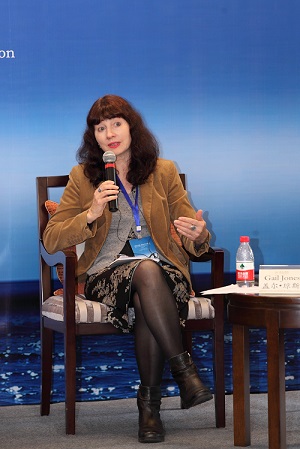盖尔•琼斯:流动与静止

流动与静止
很荣幸能够受邀参加中澳文学论坛并发言。
在发言中,我会用一些比喻来和大家分享感悟。
1.北方/西北方
最近我一直在思考罗盘的设计。罗盘上有东、南、西、北四个方位基点,还有中间方位基点等更小单位的划分,用来表示风向。有些罗盘非常华丽,以两个并不重合的北方,即真北(测地学)和磁北为中心,分布着错综复杂的各种划分和方位。
罗盘既表示方向,也表示矢量,即它表示风、电流、以及隐形的流动性。在我看来这是对想象力的一种比喻,探索思考和写作是如何通过超自然的力量为我们打开新的视野,将我们带到新的空间。
我对中国文化的想象始于西澳大利亚州西北部,小时候我在布鲁姆小城附近生活过几年。那里最初以采珠业为经济基础,曾是一个亚裔原住民小镇。当时亚裔采珠工人已经不再受所谓的“白澳政策”的限制,因此小镇上的大部分居民都来自中国、日本、马来西亚和菲律宾,还有一些是当地的原住民。Jugun和亚伍如部落则历来是这片区域的守护者 。当我还小的时候,这个小镇几乎与世隔绝,十分贫穷,并且在逐步走向衰败。当时人口只有大约1200人,其中有400人,包括儿童在内,是白人或欧裔澳人。在这里,我目睹并体验了不同的语言、食物和风俗,并且长久以来一直被亚洲本土多元的文化深深吸引着。以至于我觉得自己的“白人身份”反倒是一种异常,在文化上也很无趣。
“唐人街”位于布鲁姆市中心。尽管这里也有一些殖民时期风格的建筑和白人经营的商铺,但是只有挂着唐记、荣记和方记这类招牌的中国商店才最吸引我。除此之外,阳光电影院也是一个充满了想象的地方。孩子们在这里无忧无虑,天真烂漫:他们生性自由,珍爱这些独特的异国风情,还追求不同体验带来的快乐。我并不是想感伤童年时代或者描述那段时光,我感兴趣的是流动而富有活力的想象力为何能够在这里产生;以及这些想象力又是如何在与其他事物的种种邂逅中形成。中国面条、中文、烟火、以及中国人的面容等中国元素,在成人的生活或写作中也许早已司空见惯,但对于我这个小孩子来说,却对我对文化的理解产生了深远的影响。我时常想,这 样复杂的文化环境或许正是我成为一名作家的基础,这样想来也是件浪漫的事。当然我们都知道,在写作时我们作者的身份似乎是固定的,但实际上却是临时的,随意的,不断变化的;而语言本身则像阵阵清风不时地吹打着我们。
2.南方和南风
有一天我和哥哥来到唐记商店。我在食品货架之间走来走去,我喜欢堆起来的米粉、罐头和包装上印着的红色的鹤和龙,棕色和深红色的神秘酱料;我还喜欢新加坡的蚊香和广州丝绸做的手提包。我还没想好要买什么,哥哥彼得就买了一个袖珍罗盘。他小心翼翼地打开罗盘的圆盖子,仿佛是要打开一个神秘的箱子,然后他指着罗盘上的南方说:“我们在这儿。”我当时完全不懂他在说什么。我根本不知道我们生活的南方是指哪里(虽然我父母后来提到过“北上”,但我仍然不明白),罗盘对我来说也是一件完全陌生的物品。写作,或是对造成自然界这些划分的力量提出疑问,或是思考对于其他人来说,我们所处的东南西北种种方位。经过这样的思考,哥哥当时说的这些奇怪的话后来似乎给了我启示:再错综复杂的罗盘也是遵循着各种动态的关系来分割布局的。哲学家阿多诺曾写道:
“距离不是安全区,而是张力场。保持距离不是放松对真理的追求,而是进行细致入微的思考。”
这对我而言是一种明智的构想。要想真正了解不同的文化和跨文化间的关系,靠的不是主观断言,而是靠人们对自己的假设做出细致微小的改变,这需要谦虚地学习,并且保有对新事物感到惊奇的能力。
3.东方/西方
“东方”和“西方”这两个概念对我们的思想造成了多大的压抑啊。 周蕾把西方和中国这两个概念的对立称为“认识论的负担”:这是源于西方傲慢无知时期的一种意识形态模型,这种意识形态以政治的战略规划,和西方自己提出的所谓的“东方主义”为基础。这与儿童时期对异域文化的好奇、包容和欣赏完全不同。
大家都知道罗盘是中国发明的。它始于汉代(约公元前200年),最初用于占卜。到了宋代(11世纪),罗盘被用于航海。直到13世纪初期,欧洲人和阿拉伯人也开始在旅行中使用罗盘。大家都非常了解中国思想的中心内容,即文体。 那么流动性、方向和想象,这些简单的联系在我们考虑两国文学友好交流的时候又发挥了怎样的助力?马来西亚华裔理论家桂伟新提到了“世界主义”文学,并支持“批判性民族” 文化流动模式。民族与国家是不同的概念,我们文学工作者应该承认,任何民族的文化都是有待补充的,是复杂的。
这也让我们再次思考文学作品:小说究竟是什么?它像一个罗盘,包含能量和矢量,还包括如风一样阵阵吹拂的想象力,在变与不变,本土与外界,以及多元的世界间反复协商,最终形成文字。它就像罗盘上的中间方位基点,不同的语言表达方式则像气象标识,表示不断变化的文化“气压”和运动。我们终究都是自然的产物。我们对美的感受无需遵从任何派系或陈词滥调,又或是民族寓言和神话,而应当最终形成新的理解。
关于该地区原住民守护者的更多描述,见芭芭拉•格罗辛斯基《“一”在西澳大利亚州布鲁姆的含义,:从亚伍如部落到鲁比比公司》,《原住民历史》,1998年,第22卷,203-221页。
西奥多•阿多诺,《最低限度的道德》(《最低限度的道德:对毁掉了的人生的思索》E.F.N.杰夫考特译,伦敦:沃索出版社,2005)127页。
周蕾,《中国性:作为一个理论问题》,周蕾编,《理论时代的中国现代文学文化研究》(美国北卡罗莱那州达勒姆:杜克大学)2-25页。
即英语母语者所说的style(文体),如《诗经•国风》。
桂伟新,《民族意识和世界主义文学:全球时代下的后殖民文学》俄亥俄州立大学,2013。
Mobility and Place
Gail Jones
It’s a great honour to speak at the CALF forum: thank you for inviting me.
My method in this short talk will be metaphoric.
I. North/ Northwest
I’ve been thinking recently of the design of the compass rose: there are the four cardinal points - North, South, East and West - and there are the smaller divisions (the inter-cardinal) that suggest, among other things, the direction of the winds. Some compasses are very ornate, with intricately drawn partitions and directions, and all centre on the odd contradiction of two norths, the so-called true (geodetic) and the magnetic north.
The compass indicates both direction and vector: so it references wind, currents and invisible mobility. This seems to me metaphoric of imagination itself - and how the business of thinking and writing moves us metaphysically to new visions and spaces.
My own Chinese imaginary began in north-west Western Australia, where as a child I lived for several years near the small town of Broome. Based initially on a pearling industry, this was an Asian-Aboriginal town, (Asian pearl workers had been exempted from the so-called White Australia Policy) with a majority population of Chinese, Japanese, Malay, Filipino and Aboriginal people. The Jugun and Yaruwu tribes were the traditional custodians of this land . When I was a child, the town was isolated, impoverished and sadly diminished and had a population of only about 1200 people of whom 400, including the children, were considered ‘white’ or European. In this place I saw and experienced other languages, foods and customs, and the deep abiding appeal of an Asian-indigenous multi-culture. I felt my own ‘whiteness’ to be an aberration and culturally dull.
‘Chinatown’ was then the very centre of Broome, and although there were colonial style buildings and white owned businesses and stores, it was the Chinese shops – Tangs, Wings and Fongs – that were for me the most attractive. The movie house, Sun Picture Gardens, was also a location of extravagant imagining. Children are blithely unaware of their ignorance: they cherish idiosyncratic exoticisms, they seek the pleasure of difference, they are instinctively excursive. Without wishing to sentimentalize or essentialize childhood, I am interested in how the mobile and energized
capacities of imagining begin here; and how too they are constituted by their encounters with otherness. Chinese noodles, Chinese language, fireworks, faces - elements that might in adult life or writing seem a clichéd repertoire of obvious images, were for my child-self profoundly relativizing of my own cultural understanding. I like to think - and this may be romantic - that this complicated cultural space was the foundation 盖尔•琼斯of my vocation as a writer. Certainly we all know when we write how emplaced identity seems, but also how provisional, wayward and displaced we in fact are; how language itself is a kind of wind that constantly moves and buffets us.
2. South and the Southerly
I went one day into Tang’s store with my older brother. While I roamed among the food-stuffs - I loved the nests of rice noodles, the red stamped cranes and dragons on tins and packages, the mysterious brown and crimson sauces; while I considered and Singaporean mosquito coils and purses of Guangzhou silk, my brother Peter bought a small pocket compass. He opened its circular lid with solemnity, as if opening a secret casket, pointed to the South and said, “we are here”. It was a meaningless moment. I had no idea what South we lived in (since my parents talked of being “up North”) and the compass was an entirely alien object. One aspect of writing is surely to question the power of these categories, or to consider how we are all north, south, east and west to someone else. In this way my brother’s strange words later seemed a revelation: even the glorious compass rose was contingent in terms of dynamic systems of relations. The philosopher Adorno once wrote:
“Distance is not a safety zone but a field of tension. It is manifested not in relaxing the claim of ideas to truth, but in delicacy and fragility of thinking.”
This seems to me a wise formulation. True understanding of the intercultural and cross-cultural is surely premised not on assertion but on delicate and fragile revision of one’s own assumptions, on the modesty of learning, and on the ability to be surprised.
3. East/West
How oppressed we are by “East” and “West”. Rey Chow calls West/China an “epistemological burden”: it is an ideological model born of centuries of Western condescension and ignorance; not a childhood ‘exotic’, which is a generous and wondering admiration, but one founded on and contaminated by strategic projection and its own kind of ‘orientalism’.
Everyone here will know that the compass is a Chinese discovery: it was a device for divination in the Han dynasty (around 200BC) and adopted for navigation in the 11th century by the Song Dynasty. Only later, in the early 13th century, did Europeans and the Arab world understand the use of the compass for travel. Everyone here will know too of the centrality of wind to Chinese thinking, the pathological or curative feng. So how might these simple connections - mobility, directions, imagining as a spirited drift or ambient presence - work to help us consider literary rapprochement between nations? The Malaysian-Chinese theorist Weihsin Gui speaks of a literary “cosmopolitics” and argues for a model of cultural flows that engages a project of “critical nationality” . The nation is not the same as the state, and there are ways in which those of us engaged with literature can acknowledge the unfinished status and complexity of any nation’s culture.
This might also oblige us to think again of literary texts: What is a novel? It is a container of energies, and vectors, and the gusty waft of imaginings. It is in relentless negotiation with place and displacement, with the local and the other, and with the multi-directionality of worlds that are made of words. It is inter-cardinal; its routes of expression are often the atmospheric sign of shifting cultural pressures and movements. We are all finally creatures of the wind, the wind of breath, and our aesthetic sympathies do not need to conform to factions or truisms, national allegories or mythologies, but might, in the end be the crafting of a new comprehension.
For a description of the complexity of Indigenous land custodianship in the area, see Barbara Glowczewsk “The meaning of ‘One’ in Broome, Western Australia: From Yawuru tribe to Rubibi Corporation” Aboriginal History 1998 vol 22 pp203-221
Theodore Adorno Minima Moralia (Minima Moralia: Reflections on a Damaged Life. Trans. E.F.N. Jephcott. London:Verso 2005) p127
Rey Chow, ‘On Chineseness as a Theoretical Problem’, in Rey Chow, ed., Modern Chinese Literary and Cultural Studies in the Age of Theory: Reimagining a Field (Durham, NC: Duke UP, 2000), pp. 2-25.
I am thinking of the way this might also indicate what English speakers call a style, as in 国风, the Book of Songs.
Weihsin Gui, National Consciousness and Literary Cosmopolitics: Postcolonial Literature in a Global Moment Ohio State University 2013


